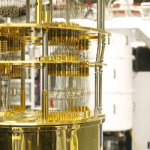Chance Discovery May Bring Quantum Computing Using Standard Microchips a Step Closer
(Science.mag)Scientists have dreamed of using atomic nuclei embedded in silicon—the familiar stuff of microchips—as quantum bits, or qubits, in a superpowerful quantum computer, manipulating them with magnetic fields. Now, researchers in Australia have stumbled across a way to control such a nucleus with more-manageable electric fields, raising the prospect of controlling the qubits in much the same way as transistors in an ordinary microchip.
The researchers discovered the effect by accident. For reasons that have nothing to do with quantum computing, they had wanted to study how the antimony nucleus embedded in a silicon chip would react to jolts of the oscillating magnetic field generated by a wire on the chip. But the wire melted and broke. It took a month for researchers to figure out what was going on, says Serwan Asaad, a postdoc at UNSW. That’s “longer than I would like to admit to a reporter,” he says. Morello says theorists predicted in 1958 that an oscillating electric field could flip a nucleus, but no one had observed it.
The embedded antimony nucleus isn’t exactly a qubit because it has eight basic states, notes Gavin Morley, a quantum physicist at the University of Warwick. But that’s OK, he says, because eight states are actually equivalent to three two-state qubits.
It’s too early to say whether nuclei in silicon will succeed as qubits. Still, the advance highlights the allure of silicon technology to build a compact quantum computer. If a silicon-based quantum computer is possible, it may be inevitable. “There’s a saying that if something can be done in silicon, it will be done in silicon, just because the industry is so big.”





















